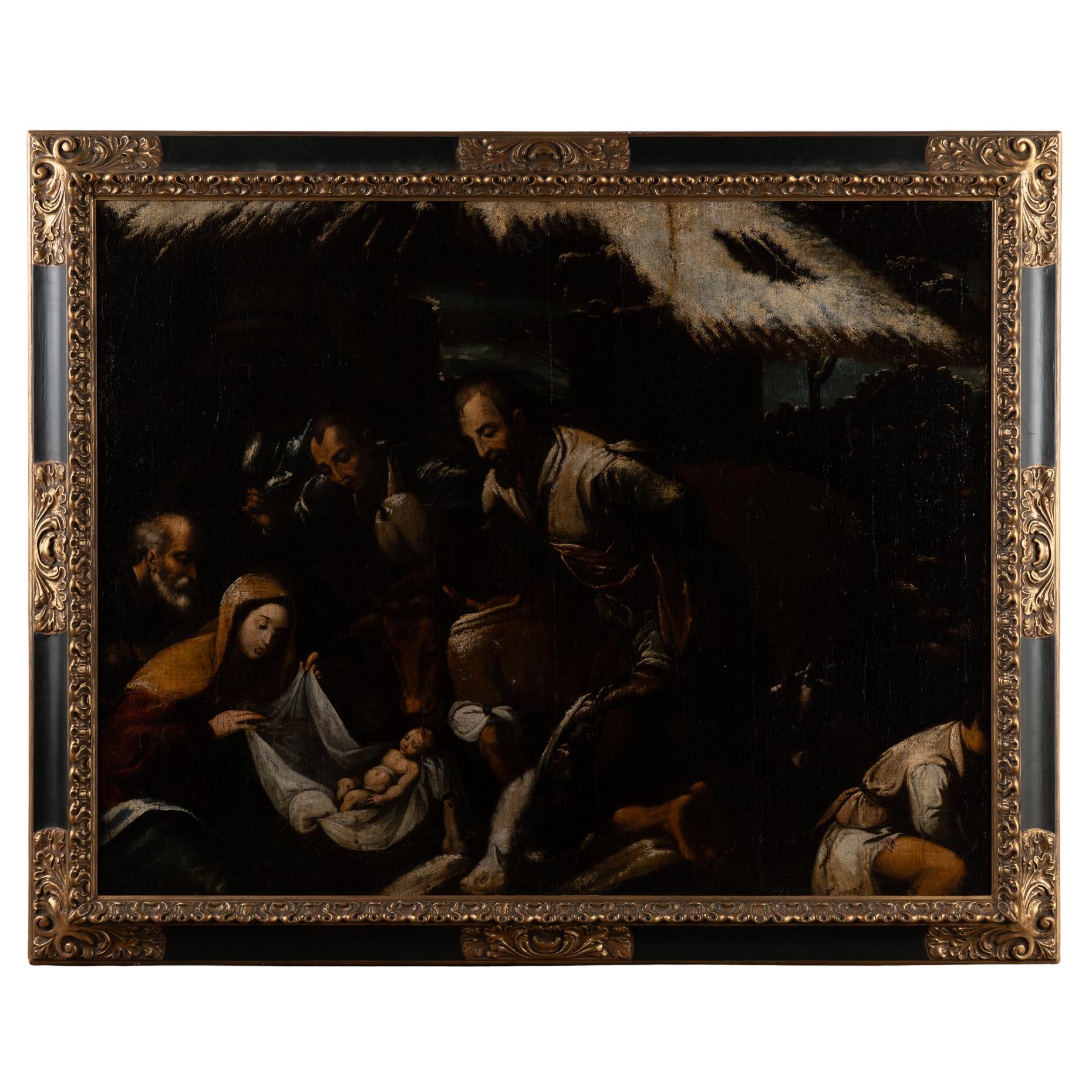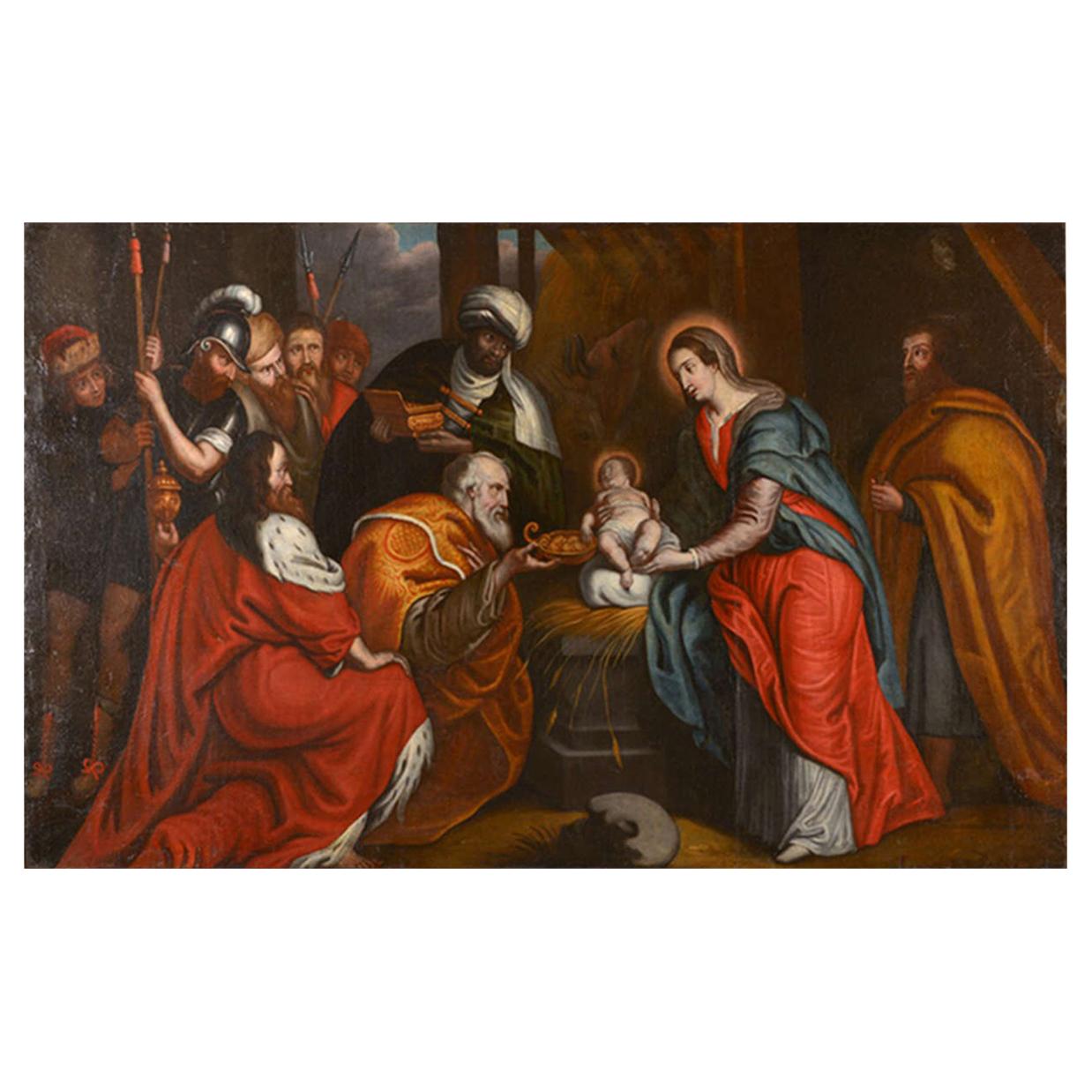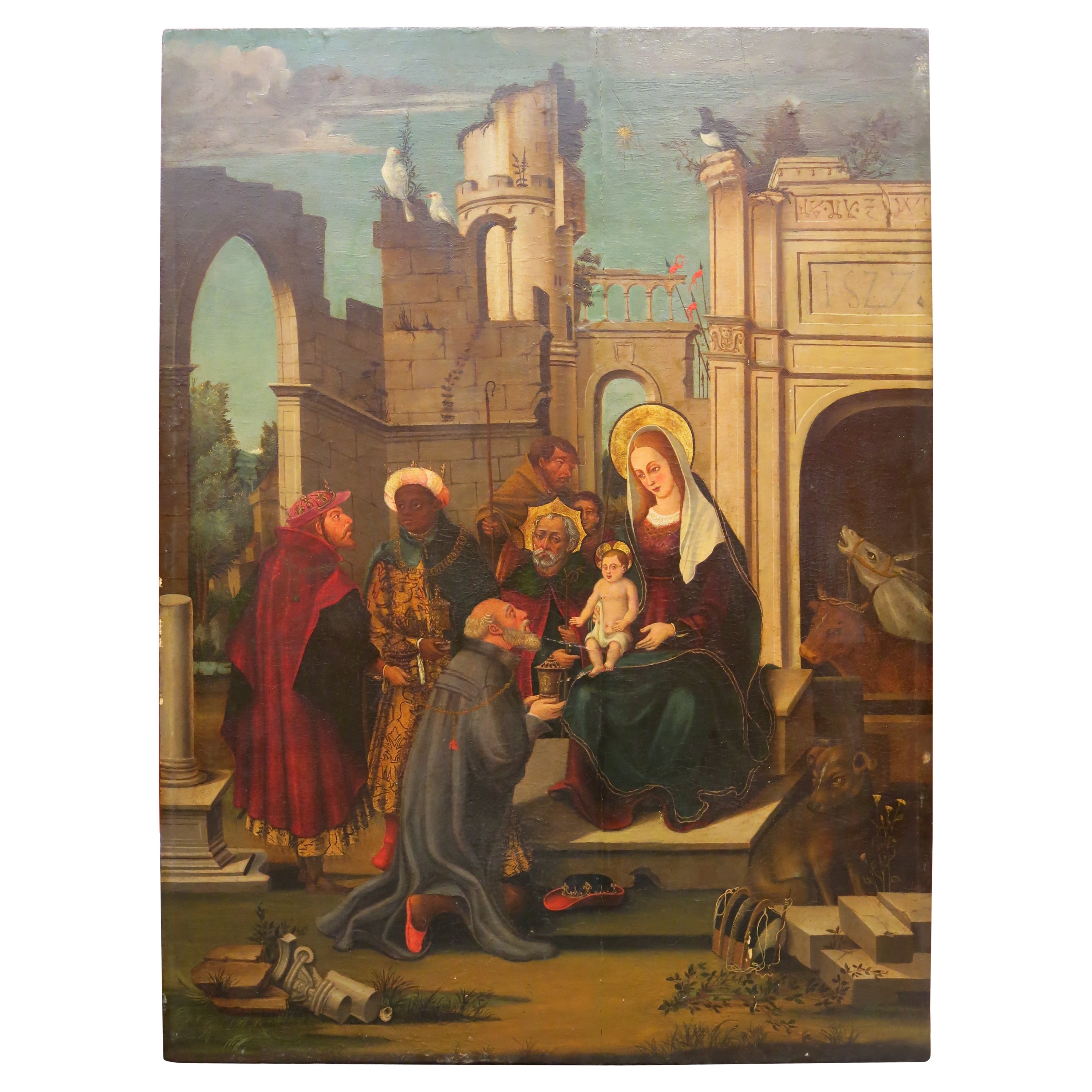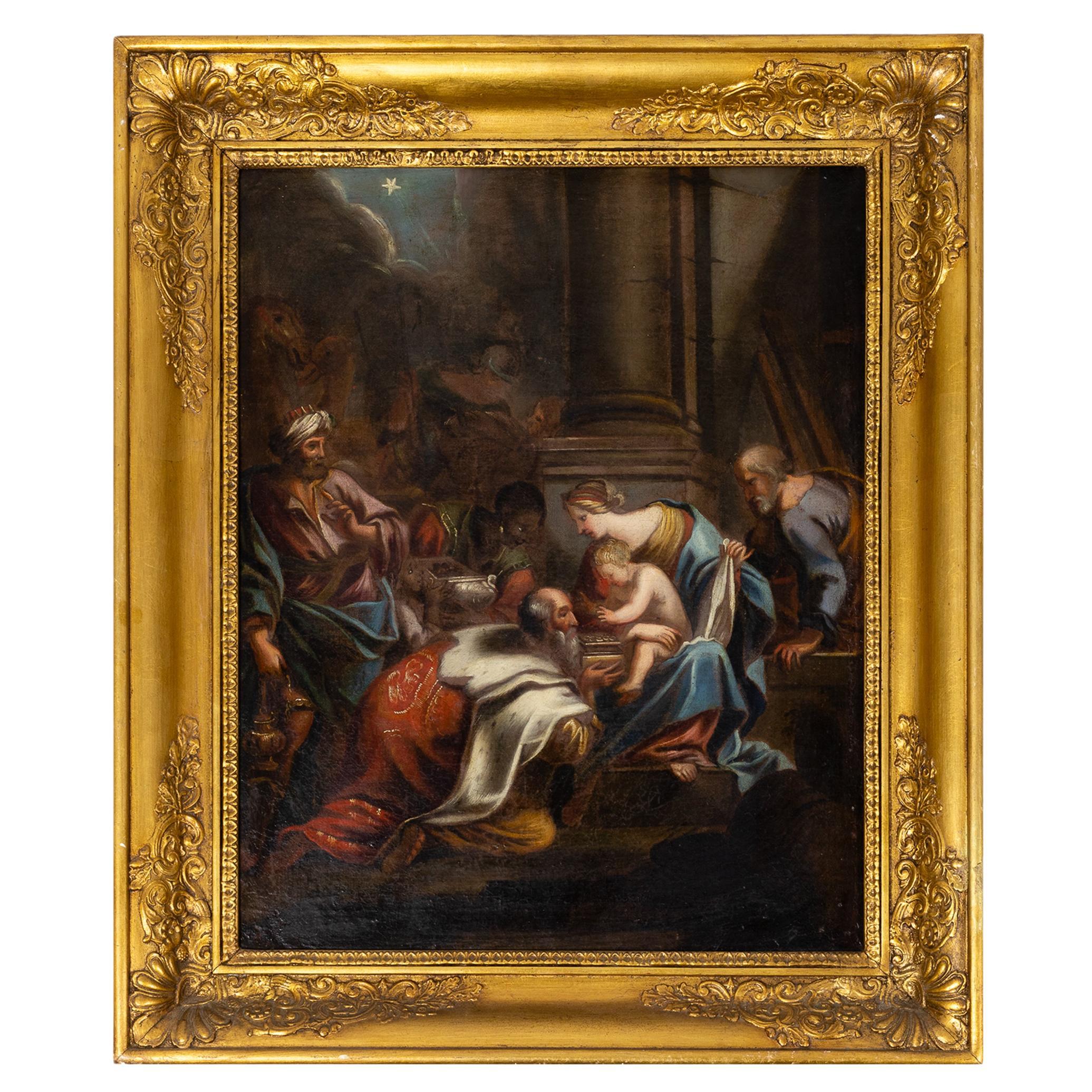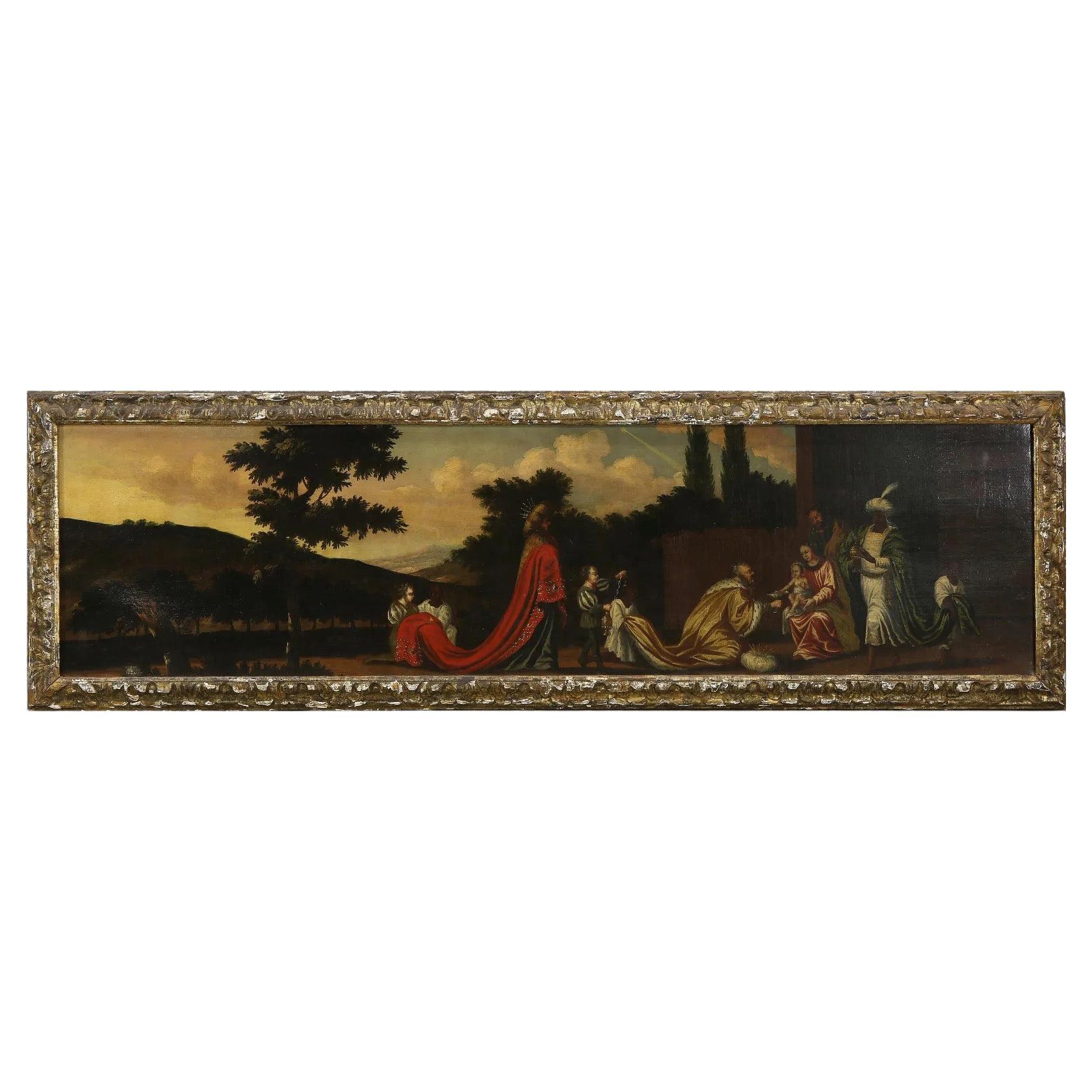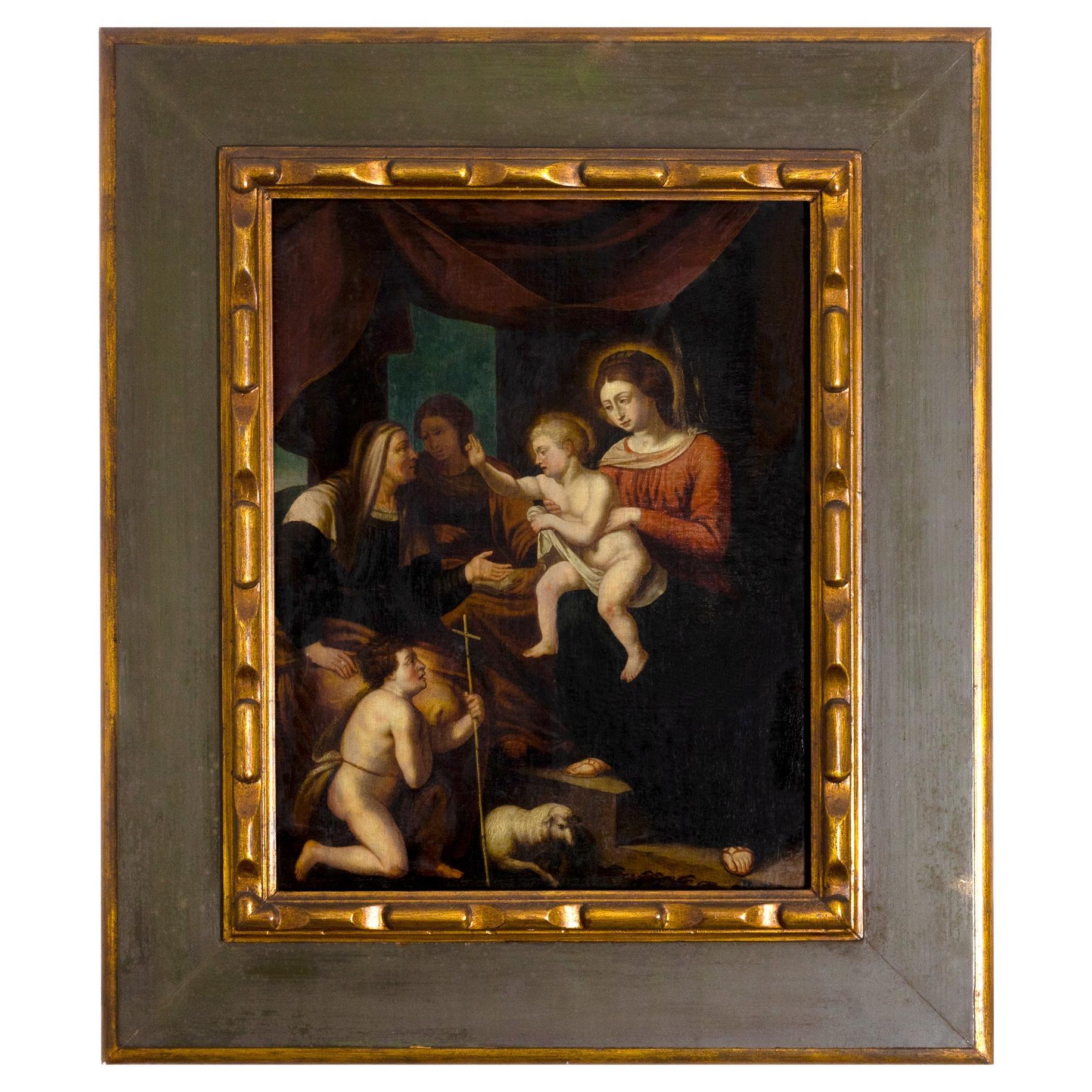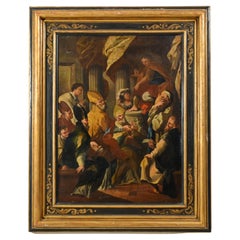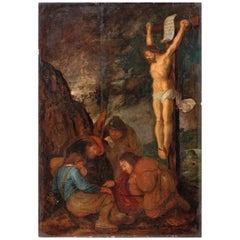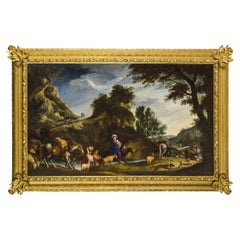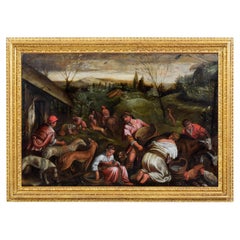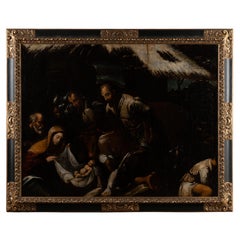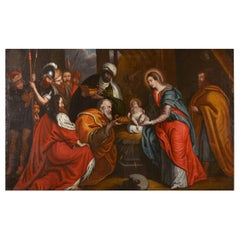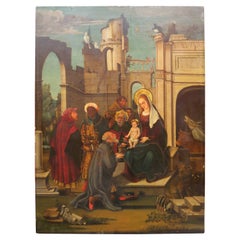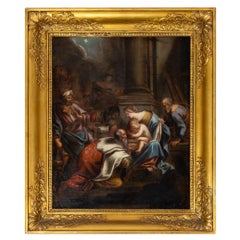Items Similar to Frans Franken III 16th Century Oil on Wood, Adoration of the Magi, Painting
Want more images or videos?
Request additional images or videos from the seller
1 of 11
Frans Franken III 16th Century Oil on Wood, Adoration of the Magi, Painting
$33,080.67
£24,796.01
€28,000
CA$45,447.22
A$50,737.55
CHF 26,585.71
MX$621,077.38
NOK 337,638.81
SEK 318,350.53
DKK 213,146.22
About the Item
Frans Franken III and aid, Adoration of the Magi
Good condition
The oil painting on wood, with a gold background, depicts an Adoration of the Magi. The Magi are dressed in sumptuous silk and brocade dresses; they wear precious hats and jewelery. The richness of their garments is in contrast with the humility of the Holy Family and of the other characters who, around curious, observe the scene. The hut is simple, made of wood and straw: above it shines the Comet, symbol of the divine event. In the distance, a group of wayfarers walk along a path that is lost on the horizon, blending into the gold of the bottom.
The representation proposes a traditional iconography, in which the painter inserts some details that he lends himself to symbolic interpretations. Among these is the appearance of the Magi, who from the XIVth century differs iconographically: the wise astronomers represent the homage to Jesus of the then known parts of the world, namely Africa, Asia and Europe. To the right of the Magi, in the foreground, sits a monkey, considered a demonic creature and a symbol of lies and sin. It is depicted on the sidelines, as a defeat, next to a fragment of a classical column: ruin alludes to the end of paganism, of the old world that collapses with the advent of the new one, marked by the birth of Christ and liberation from the Original Sin. On the ruins he climbs the ivy, symbol of the immortality of the soul. The work is attributable to the workshop of the Flemish painter Frans Francken III, belonging to a prolific family of Antwerp painters who for four generations played a predominant role in local art. The comparison with a painting by Frans Francken III, preserved at the Museum of Fine Arts in Tournai, Belgium, is likely. In this work the same composition is represented, with some color variations and in which the artist describes, in the background, a glimpse of a Flemish city with houses, a bridge under which a river flows and some inhabitants. The blue sky is marked by a few clouds and some bare trees suggest the winter season.
Frans Francken III (Antwerp, 1607-1667) belongs to the Francken painter dynasty. Son of Frans Francken II and Elisabeth Placquet, he trained in his father's workshop. In 1639-40 he joined the Corporation of San Luca and in 1656, in recognition of the fortune his works received, he became its dean. His ability to paint small figures means that he is often requested by other artists to animate compositions of landscapes or interiors with staffage figures.
Frans Francken III specializes in small paintings, painting subjects both sacred and profane.
His works, characterized by the vividness of the colors, vary in the narrative richness according to the request and taste of the clients and their economic possibilities. Often overworked, the help of workshop collaborators who skillfully imitate their style is used. He has several students, including Carstian Luyckx and Jan Baptist Segaert.
We apologize for the translation errors.
Please, contact us for the italian expertise
- Creator:Frans Franken the Younger (Painter)
- Dimensions:Height: 28.75 in (73 cm)Width: 35.83 in (91 cm)Depth: 1.97 in (5 cm)
- Style:Renaissance (Of the Period)
- Materials and Techniques:
- Place of Origin:
- Period:
- Date of Manufacture:16th Century
- Condition:Please, contact us for the italian expertise.
- Seller Location:IT
- Reference Number:1stDibs: LU4405214596631
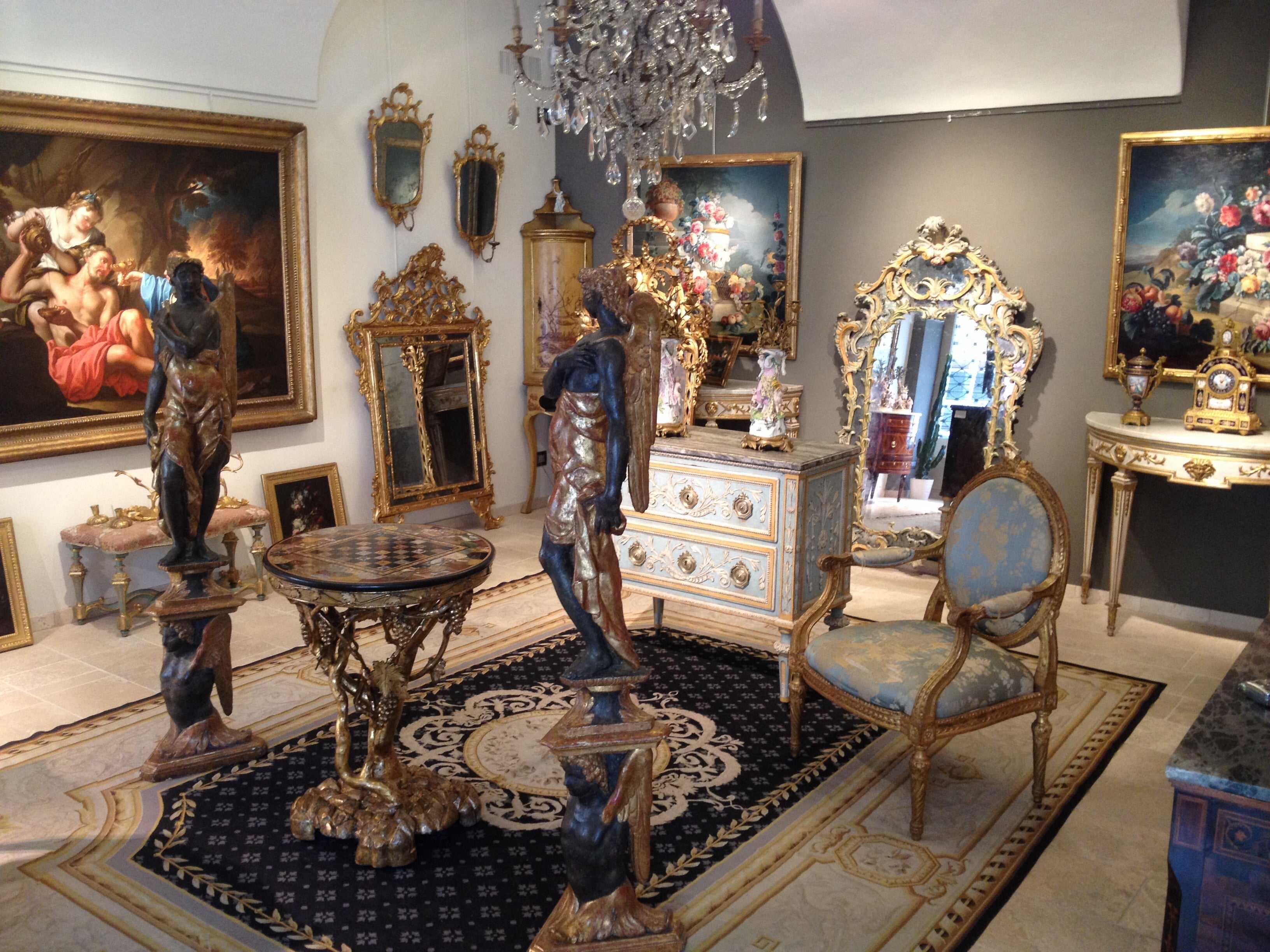
About the Seller
5.0
Platinum Seller
Premium sellers with a 4.7+ rating and 24-hour response times
Established in 1980
1stDibs seller since 2019
56 sales on 1stDibs
Typical response time: 1 hour
- ShippingRetrieving quote...Shipping from: Italy
- Return Policy
Authenticity Guarantee
In the unlikely event there’s an issue with an item’s authenticity, contact us within 1 year for a full refund. DetailsMoney-Back Guarantee
If your item is not as described, is damaged in transit, or does not arrive, contact us within 7 days for a full refund. Details24-Hour Cancellation
You have a 24-hour grace period in which to reconsider your purchase, with no questions asked.Vetted Professional Sellers
Our world-class sellers must adhere to strict standards for service and quality, maintaining the integrity of our listings.Price-Match Guarantee
If you find that a seller listed the same item for a lower price elsewhere, we’ll match it.Trusted Global Delivery
Our best-in-class carrier network provides specialized shipping options worldwide, including custom delivery.More From This Seller
View All18th Century, Italian painting with Saint Nicholas and the miracle of the brick
Located in IT
18th Century, Italian painting with Saint Nicholas and the miracle of the brick
Oil on canvas; Frame cm H 136 x W 109 x D 10. Canvas cm H 100 x W 74
The oil on canvas painting, with...
Category
Antique 18th Century Italian Baroque Paintings
Materials
Canvas
17th Century Flemish Oil on Panel Monogrammist H.C., Soldiers Gambling for Tunic
Located in IT
17th century Flemish oil on panel Monogrammist H. C.
"Soldiers gambling for Christ's tunic"
The fine painting depicts the biblical scene i...
Category
Antique 17th Century Dutch Baroque Paintings
Materials
Wood
17th Century, Italian Painting by Pier Francesco Cittadini, Jacob and his Family
Located in IT
Pier Francesco Cittadini (Milan, 1616-Bologna, 1681)
"Jacob and his family go to Egypt"
Oil on canvas, cm 109 x 190 (canvas only)
The valuable painting, made in oil on canvas, depicts Jacob and his family go to Egypt and we believe it can be, given the high quality painting, autograph work of Italian Pier Francesco Cittadini (Italy Milan, 1616 - Bologna, 1681) made after 1647. The work, in excellent condition is accompanied by a coeval frame in wood finely carved and golden.
The scene depicted, which was confused with the Flight to Egypt in the past years, is instead identified with the biblical episode of Jacob’s journey. In the foreground, reading the painting from left to right, we see a caravan composed of animals, including donkeys, dromedaries, goats, dogs and horses and people, women, men and slaves, who carry on their journey along the banks of a river, following a path that to the right, would seem to lead to the through of a bridge. In addition to the watercourse is described an environment characterized by large rocks and impervious come far to cover the entire verticality of the canvas. On the left, in the distance, we see the tail of the caravan that runs along the steep path. Large trees enliven and harmonize the environment, as well as white and grey clouds characterize the predominantly clear sky and illuminated on the right by sunlight.
The story is told in the Bible, Book of Genesis, 30, 25, passage in which is described the flight of Jacob from Haran after the contrasts with Laban, father of his wife Rachel. Jacob is the third great patriarch of the Bible. From his descendants originate the twelve generations of the people of Israel. He is the son of Isaac and Rebekah, who led him to flee from the wrath of Esau to Haran to seek refuge from his brother, Laban. At his uncle’s house Jacob met his daughter Rachel. As soon as he saw his cousin, Jacob was taken. Jacob will stay seven years in the service of Laban to marry his beloved Rachel. But Laban, with a deception, will give him in marriage first Lia, the least beautiful eldest daughter, and only after another seven years the splendid Rachel. From his first wife he will have several children, while Rachel will give birth to the beloved son, Joseph, who will become viceroy of Egypt.
After years of service, Jacob asked to be paid with every dark-coloured garment among the sheep and every spotted and dotted garment among the goats. Laban accepted and sent away from his sons all the leaders of that kind. So Jacob took fresh branches of poplar, almond and plane tree, and flayed them, and put them in the troughs. The optical suggestion induced the goats and the sheep to conceive and give birth to dark, striped and dotted garments. He also ensured that all the strongest and healthiest leaders of the flock of Laban would drink near the barked branches, thus assuring a genetic superiority to his part of the flock. His flocks grew numerous and strong and he became richer than his relative, arousing envy. It was clear that Laban would not respect him much longer. At the suggestion of the Lord, Jacob decided to return to Canaan. Trying to avoid any possible dispute, he left with his family while Laban was absent for shearing sheep. But when, three days later, his uncle returned home, he became angry, feeling offended because Jacob had gone secretly and had not allowed him to greet his daughters and grandchildren. In addition, his teraphim, statuettes, or idols, which depicted the family deities, had disappeared. After 7 days of pursuit, Laban and his men reached Jacob’s group on Mount Gilead, in the mountainous region west of the Euphrates River, where his uncle and grandson had a stormy conversation. The younger man was outraged at being accused of stealing idols and told Labano to rummage through his family’s tents at will. Neither of them could know or even imagine that it was Rachel who took the idols and hid them in the saddle of the camel. During the search, she sat down firmly on the saddle, apologizing for not being able to get up, «because I usually have what happens to women» (Gen 31:35). So the loot wasn’t discovered.
The author of this work was inspired by the composition of an engraving by Stefano Della Bella (1610-1664) of circa 1647. The engraving by Stefano della Bella bears the title "Iacob sur ses vieux jours quitte sans fascherie pour voir son filz Ioseph, sa terre et sa patrie" and is signed on the bottom left "Stef. of the Beautiful In. et fe." while on the right it is declared "Cum privil. Regis", that is with license of the king.
Stefano Della Bella (Italy - Florence, May 18, 1610-Florence, July 12, 1664) was born in a family of painters, sculptors and goldsmiths and was left early orphan of his father sculptor, he dedicated himself first to the art of goldsmith at the school of Giovanni Benedetto Castiglione and Gasparo Mola, then turning his attention to drawing and engraving. He soon began drawing figures and copying the etchings of Jacques Callot, which inspired his early works. Under the protection of the Medici, in particular of Don Lorenzo, cadet son of Grand Duke Ferdinand I, Della Bella has the opportunity to make study trips to Rome, where he stayed from 1633-1636; In Rome he met French engravers and publishers of prints such as Israël Henriet and François Langlois, who influenced his decision to move to Paris in 1639, four years after the death of Callot. In Paris he soon reached, thanks to the engravings commissioned by Cardinal Richelieu, the success also worldly; he frequented courtiers, theatre artists and writers, while refusing too oppressive honors. In 1646-1647 he continued his travels in the Netherlands to Amsterdam, Antwerp and Dordrecht. He returned to Florence in 1650 and resumed working under the protection of the Medici court, working for his patrons. In 1656 he became a member of the Academy of Apatists.
The painting object of this study is reasonably attributable to Pier Francesco Cittadini, or Pierfrancesco Cittadini, called the Milanese or the Franceschino (Italy - Milan, 1616-Bologna, 1681) as some exemplary stylistic comparisons proposed to follow can prove.
Pier Francesco Cittadini was an Italian baroque painter, mainly active in Bologna.
His artistic training first took place with the painter Daniele Crespi...
Category
Antique Mid-17th Century European Baroque Paintings
Materials
Canvas, Giltwood
17th Century, Italian painting Allegory of the Spring Follower of Jacopo Bassano
By Jacopo Bassano
Located in IT
Follower of Jacopo Da Ponte, called Jacopo Bassano (Bassano del Grappa, circa 1510 - Bassano del Grappa, 13 February 1592), 17th century
Allegory of the Spring
Measures: With frame: ...
Category
Antique Late 17th Century Italian Baroque Paintings
Materials
Canvas
18th Century, Baroque Austran Painting by August Querfurt
Located in IT
August Querfurt (1696, Wolfenbüttel - 1761, Vienna)
Farmers and villagers at the entrance of a village
Oil on panel , cm 38,5 x 51. frame 66 x 53,5 x 4,5 cm
The valuable painting, ...
Category
Antique 18th Century Austrian Baroque Paintings
Materials
Wood
18th Century, Flemish Painting Banquet and Dance Scene by Jan Baptist Lambrecht
Located in IT
18th century, Flemish Painting with Banquet and Dance scene by Jan Baptist Lambrechts
Oil on canvas, Measurements: only the canvas cm H 34 x W 30; frames cm H 49,5 x W 45 x D 8
Thes...
Category
Antique Early 18th Century Belgian Louis XIV Paintings
Materials
Canvas
You May Also Like
17th Century Original Oil on Canvas Painting of The Adoration of the Magi, Spain
Located in Round Top, TX
Original oil on canvas painting of the adoration of the magi, with Mother Mary and infant Christ.
Framed over 5' wide x 4' tall, no signature/unknown artist.
Canvas has craquelure, o...
Category
Antique Early 17th Century Spanish Paintings
Materials
Canvas, Wood, Paint
Flemish 17th Century Oil on Canvas Painting of the Adoration of the Magi
Located in Houston, TX
Beautiful Flemish 17th century oil on canvas painting depicting the adoration of the magi. Vivid color and wonderful quality of pa...
Category
Antique 17th Century Dutch Paintings
Materials
Canvas
Adoration of the Magi, Catalan Baroque, S.XVI Dated 1527, Oil on Wood
Located in CABA, AR
Catalan Baroque S.XVI
The Adoration of the Magi
Oil on wood
92cm x 68cm
Dated 1527
At the beginning of the Renaissance period, Gothic forms coexisted in Catalonia with other new solutions, in which religious fervor was mixed with the attention to detail of everyday life.
Following the medieval tradition, the altarpieces are thought from a narrative vision, and flat painting...
Category
Antique 16th Century Spanish Baroque Paintings
Materials
Wood
$28,000 Sale Price
20% Off
Adoration of the Magi Paiting, Italian Baroque Religious Art, 18th Century
Located in Lisbon, PT
This 18th century Italian painting captures one of the most iconic biblical moments: the Adoration of the Magi.
The mysterious travelers kneel in reverence before the Infant Jesus, ...
Category
Antique 18th Century Italian Baroque Paintings
Materials
Canvas
$9,344 Sale Price
20% Off
17th Century Italian Flemish Oil on Canvas Painting of Adoration of the Magi
Located in North Miami, FL
17th Century Italian Flemish oil on canvas painting depicting the Adoration of the Magi. Early Flemish painting was contemporary to the development of the early Renaissance in Italy. In the middle of the 15th century Italy...
Category
Antique 17th Century Italian Baroque Paintings
Materials
Wood, Giltwood, Paint
$26,663 Sale Price
24% Off
Flemish School Painting, Adoration of the Child, 18th Century, Religious art
Located in Lisbon, PT
This 18th-century Flemish oil on wood painting depicts the moment of adoration of the Child Jesus, in the loving arms of the Virgin Mary.
Kneeling at their feet is the young Saint J...
Category
Antique 18th Century Dutch Baroque Paintings
Materials
Wood
$6,830 Sale Price
20% Off
More Ways To Browse
Monkey Tree
Italian Brocade
African Monkey
Blue Brocade Dress
Wise Monkeys
Frans Francken The Younger
19th Century French Seascape Paintings
Ames Used Furniture
Antique Oil Painting On Tin
E Dubois
Furniture Guild Of California
Italian Reverse Glass Painting
Slovak Artists
Street Signs Los Angeles
Antique Recorders
Antique Roman Oil Painting
Gregory Wells
Italian Violin
